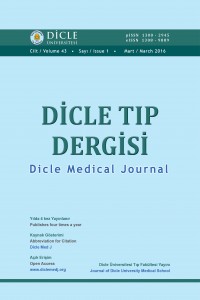Öz
Objective: Although the incidence of incidental prostate cancer (IPCa) decreases in recent years; for patients who performed by transurethral resection of the prostate (TURP) due to bladder outlet obstruction with or without prostatism symptoms (BPH), it is still can be seen. This article purposes to answer two questions a) for urologist, which clinical parameters including obesity and smoking have positive predictive value. b) for pathologists; which materials are wholly sampled for reducing the cancer ?
Methods: We evaluated 1315 cases who were performed by TURP due to bladder outlet obstruction with or without prostatism symptoms the years 2006-2015. The ages of the patients, smoking, body mass index (BMI), digital rectal examination (DRE) findings, preoperative prostate specific antigen (PSA) levels, uroflow values, total prostate volume determined by suprapubic ultrasound and Gleason score were recorded. We analyzed the relationship between these parameters and IPCa. These situation compared with benign prostate tissue materials.
Results: Totally 31 cases (2.35%) were found in the IPCa. While the cases of 24 were pT1a, 7 cases were pT1b. Age, body mass index, PSA, peak current speed and mean flow rate parameters respectively 8.887, 5.668, 9.660, 4.814 and 3.716 times as an incidental effect in detecting prostate cancer has been concluded.
Conclusion: Older patient age, over the 25 kg/m2 of BMI, over the 4 ng/dl of PSA levels, the peak flow rate less than 10 ml/sec and the mean flow rate less than 5 ml/sec might be independent risk factors for detecting IPCa. More external validation is needed for confirming our results.
Key words: Incidental prostate cancer, clinic parameters, diagnosis
Anahtar Kelimeler
Kaynakça
- Sakamoto H, Matsumoto K, Hayakawa N, et al. Preoperative
- parameters to predict incidental (T1a and T1b) prostate cancer. Can Urol Assoc J 2014;8:815-820.
- Andren O, Garmo H, Mucci L, et al. Incidence and mortality of incidental prostate cancer: a Swedish register-based study. Br J Cancer 2009;100:170-173.
- Tombal B, De Visccher L, Cosyns JP, et al. Assessing the risk of unsuspected prostate cancer in patients with benign prostatic hypertrophy: a 13-year retrospective study of the incidence and natural history of T1a-T1b prostate cancers. BJU Int 1999;84:15-20.
- Fowler JE Jr, Pandey P, Bigler SA, et al. Trends in diagnosis of stage T1a-b prostate cancer. J Urol 1997;158:1849-1852.
- Jones JS, Follis HW, Johnson JR. Probability of finding T1a and T1b (incidental) prostate cancer during TURP has decreased in the PSA era. Prostate Cancer Prostatic Dis 2009;12:57-60.
- Schaeffer AJ, Landis JR, Knauss JS, et al. Demographic and
- clinical characteristics of men with chronic prostatitis: the national institutes of health chronic prostatitis cohort study. J Urol 2002;168:593-598.
- Peskoe SB, Joshu CE, Rohrmann S, et al. Circulating total testosterone and PSA concentrations in a nationally representative
- sample of men without a diagnosis of prostate cancer. Prostate 2015;75:1167-1176.
- Davies NM, Gaunt TR, Lewis SJ, et al. The effects of height and BMI on prostate cancer incidence and mortality: a Mendelian randomization study in 20,848 cases and 20,214 controls from the PRACTICAL consortium. Cancer CausesControl 2015;26:1603-1616.
- Fowke JH, McLerran DF, Gupta PC, et al. Associations of body mass index, smoking, and alcohol consumption with prostate cancer mortality in the Asia Cohort Consortium. Am J Epidemiol 2015;182:381-389.
- Hayakawa T, Mitsuya H, Kojima M, et al. Clinical study on prostatic cancer detected incidentally by trans urethral resection of the prostate. Hinyokika Kiyo 2002;48:13-16.
- Zigeuner R, Schips L, Lipsky K, et al. Detection of prostate cancer by TURP or open surgery in patients with previously negative trans rectal prostate biopsies. Urology 2003;62:883-887.
- Al-Azab R, Toi A, Lockwood G, et al. Prostate volume is strongest predictor of cancer diagnosis at transrectal ultrasound-guided prostate biopsy with prostate-specific antigen values between 2.0 and 9.0 ng/mL. Urology 2007;69:103-107.
- Billis A, Carlos A.F, Piovesan H. Histologic carcinoma of the prostate in autopsies: frequency, origin, extension, grading and terminology. Brazilian J Urol 2002;28:197-206.
- Robinson D, Aus G, Bak J, et al. Long-term follow-up of
- conservatively managed incidental carcinoma of the prostate: A multivariate analysis of prognostic factors. Scand J Urol Nephrol 2007;41:103-109.
- Magheli A, Rais-Bahrami S, Carter HB, et al. Subclassification of clinical stage T1 prostate cancer: impact on biochemical recurrence following radical prostatectomy. J Urol 2007;178:1277-1280.
- Capitanio U, Briganti A, Suardi N, et al. When should we expect no residual tumor (pT0) once we submit incidental T1a-b prostate cancers to radical prostatectomy? Int J Urol 2011;18:148-153.
- CAP Cancer Committee. Reporting on Cancer Specimens: Case Summaries and Background Documentation. Northfield, III: College of American Pathologists. Prostate 2005;4:15-16.
Ayrıntılar
| Birincil Dil | Türkçe |
|---|---|
| Bölüm | Araştırma Yazıları |
| Yazarlar | |
| Yayımlanma Tarihi | 1 Mart 2016 |
| Gönderilme Tarihi | 29 Mart 2016 |
| Yayımlandığı Sayı | Yıl 2016 Cilt: 43 Sayı: 1 |


